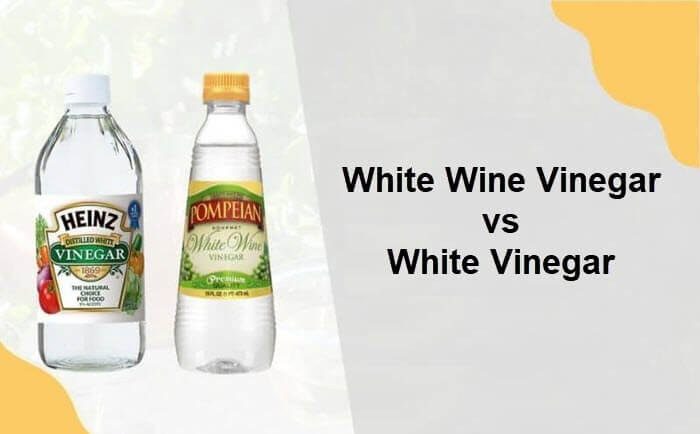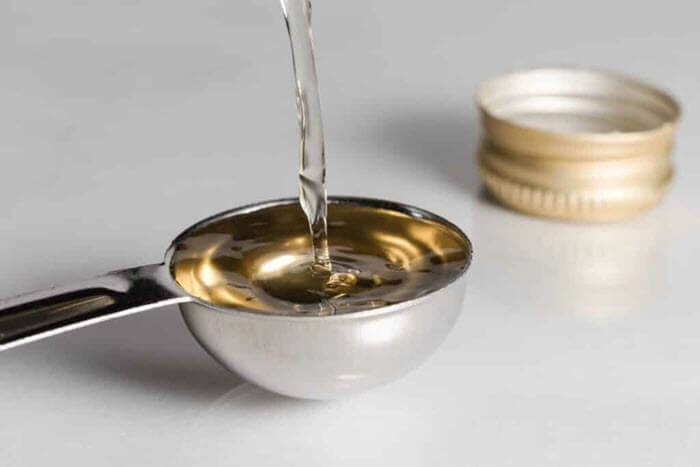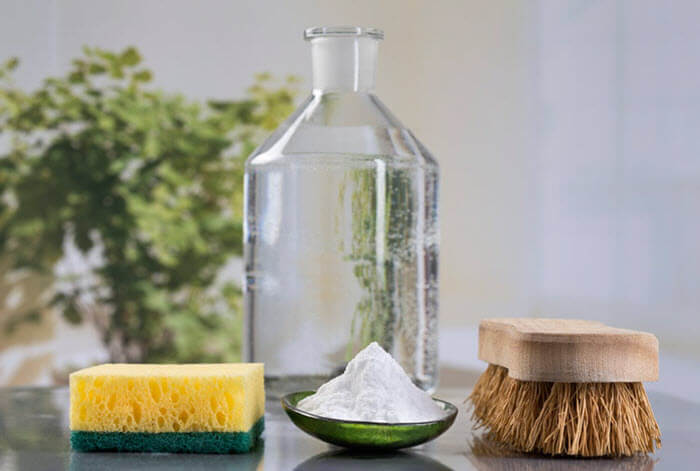Suppose you’ve looked up a recipe that requires white wine vinegar, only to discover you only have white vinegar. In that case, you might substitute without a second thought.
However, despite the similar names, there are more differences between white vinegar vs. white wine vinegar than an extra word.
Table Of Contents
Is White Wine Vinegar the Same as White Vinegar or Distilled vinegar?
The short answer to the white vinegar vs. white wine vinegar dilemma is no; they’re not the same. However, in a pinch, you can substitute one for the other in recipes.
White wine vinegar comes from white wine. You can pick up any wine from the store and, through the fermentation process [1], transform it into white wine vinegar. Because of the wide variety of white wine sources available, white wine vinegar can differ slightly in taste.
White vinegar or distilled vinegar uses neutral grain alcohol, which is vodka-like and quite strong. As a result, the taste of white vinegar is the most authentic plain vinegar flavor with few variations.
You May Like: Apple Cider vs Apple Cider Vinegar
White Vinegar vs. White Wine Vinegar: Differences
Since the two kinds of vinegar have different root ingredients, it’s no surprise that the differences remain. Here are some of the main differences between the two.
Acetic Acid
Is white wine vinegar stronger than white vinegar?
Generally speaking, white vinegar is more acidic. White vinegar typically averages an acetic acid level between 5-10%. On the other hand, white wine vinegar averages 5-7% acetic acid. While 3% might seem insignificant, it creates a sharpness you can taste.
As a result of more acidity, white vinegar wins the white vinegar vs. white wine vinegar strength contest.
The more potent substance, white vinegar, is the better choice as a cleaning product [2]. However, when it comes to cooking, some recipes might require more acidity. In contrast, others might be more to taste with white wine vinegar.
Color
To the untrained eye, telling the two apart might prove challenging.
However, pay close attention to the color because white vinegar is clear while white wine vinegar is off-white. Like the original white wine, its vinegar version displays a cloudier, often yellowish appearance.
That might seem like semantics, and in the cooking process, you won’t notice a significant visual difference in the final product.
If you’re desperate for a party trick, you can test kitchen knowledge by placing the two unlabeled side by side.
Smell
Another difference to help your party trick test is the smell. Unsurprisingly, white wine vinegar has some of the aroma notes of white wine.
Depending on the wine you start with, your white wine vinegar might smell fruity or sweet.
Contrarily, white vinegar smells sour. You’ll be making faces after taking a whiff of this stuff.
Price
While the price difference can be negligible, it’s worth noting that white vinegar is the cheaper of the two.
Suppose you intend to use vinegar as a cleaning product. In that case, white vinegar breaks down dirt easier and is more affordable, especially where you need to use a lot of it.
However, if you have a specific recipe or flavor profile in mind, white wine vinegar is worth the extra cents. As there are often a few options at the store, you’ll have a few options with wiggle room on the cost.
Usage
Both vinegar can be used in a recipe. But White vinegar is great for cleaning since it’s so acidic, while white wine vinegar is great for cooking, especially in making salad dressing.
You May Like: White Vinegar Vs. Rice Vinegar
How to Make White Vinegar or White Wine Vinegar
Are you interested in DIY white vinegar or white wine vinegar?
The first thing to know is that it won’t happen overnight. Both white vinegar and white wine vinegar need about a month and a half to be cultivated.
The second thing to note is that you need a vinegar starter, such as raw vinegar. While it’s possible to create white vinegar or white wine vinegar without raw or unfiltered vinegar, it decreases your odds of success.
By adding raw vinegar, you ensure the necessary bacteria appear in the mixture instead of accidentally making a moldy mess. However, if you don’t have a deadline and you’re trying it for fun, you can skip the raw vinegar.
Before you start, decide on a container that’s at least one gallon. You can use a mason jar or an empty wine bottle. Whatever vessel you choose, test if you can fit a balloon snugly around the top because that’s part of the magic.
What You’ll Need
Gather the following materials for your recipe:
- ½ gallon water or ½ gallon white wine
- 1 ¾ cups sugar
- 1 packet wine yeast or baking yeast
- 2 cups unfiltered vinegar
- 1 large balloon
- Cheesecloth or coffee filter
Step One
In a large cooking pot, combine half-gallon of water (or substitute with white wine) and 1 ¾ cups of white sugar. Using a medium heat setting, stir until the sugar dissolves. Then, let it cool completely.
Step Two
Pour the mixture into your chosen container, and then add one packet of wine yeast. Stretch the balloon over the opening and set the container aside for two weeks in a room-temperature area.
The balloon will fill with causes, allowing fermentation. Watch for the balloon over-filling and release some air if it seems like it’s about to burst.
Step Three
After two weeks, it’s time to remove the balloon. Pour in your two cups of unfiltered vinegar, cover the container with cheesecloth, and secure it with an elastic band.
Then, let it sit another three to four weeks.
During this time, you’ll see a smooth film form on the surface of the cheesecloth, referred to as the vinegar “mother.”
At the three-week mark, do a smell test. If it smells like vinegar, try a taste test. If the taste isn’t strong enough, set aside for another week.
Step Four
Once you’re satisfied with the taste, strain the contents using a cheesecloth. You can save the strained “mother” for future fermentation instead of purchasing a starter, or you can dispose of it.
Alternatively, for white wine vinegar, a simple hack is to set aside an open ¾ full bottle of white wine.
Let it sit for a few weeks, and then add it! Although we recommend covering it with a filter or cheesecloth to keep away curious flies.
Once you’ve successfully made your white vinegar or white wine vinegar from scratch, store it in a refrigerated space and use it as you will.
Which version are you ready to try?
You May Like: White Vinegar Vs. Apple Cider Vinegar
FAQs About Vinegar You Should Know
Is rice vinegar the same as white vinegar?
No! Although they have similar color, the flavors of them are completely different. Rice vinegar tastes delicate and sweet while white vinegar is harsh and sour.
How to store vinegar?
Since the direct sunlight will cause the vinegar to ferment further, changing its taste, it’s wise for you to store vinegar in a dark & cool place. Don’t forget to replace the cap every time after opening.
You should throw your vinegar out when it has an unusually sour taste or appears cloudy.
Is white wine vinegar the same as white cooking wine?
They have different tastes! White cooking wine is usually used for cooking applications, such as adding it in a sauce. It can’t be a substitute for white vinegar since it’s not acidic enough.
You may like: 8 Best White Wine Vinegar for Salad Dressing/Cooking



